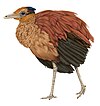极地鸟属
| 极地鸟属 化石时期:白垩纪晚期
| |
|---|---|
| 科学分类 | |
| 界: | 动物界 Animalia |
| 门: | 脊索动物门 Chordata |
| 纲: | 鸟纲 Aves |
| 演化支: | 雁形类 Anserimorphae |
| 目: | †维加鸟目 Vegaviiformes |
| 科: | †维加鸟科 Vegaviidae Chatterjee 2002 |
| 属: | †极地鸟属 Polarornis Chatterjee 2002 |
| 模式种 | |
| 杰氏极地鸟 Polarornis gregorii Chatterjee 2002
| |
极地鸟属(学名:Polarornis)是雁形类(Anserimorphae)已灭绝的一个属,属维加鸟科,仅有Polarornis gregorii一种,其化石出土于南极洲西摩岛Lopez de Bertodano组,年代为距今约6600万年白垩纪晚期的马斯特里赫特期。极地鸟最早于1988年由古生物学家桑卡尔·柯特吉发现[1],但直到2002年才正式描述发表[2],不过他在1997年便在其著作The Rise of Birds中使用了本属的学名[3]。
分类[编辑]
柯特吉将极地鸟属归入潜鸟科,认为其为潜鸟较早分支的类群,许多学者认同此观点[4][5],但也有人反对,例如杰拉尔德·梅尔即认为极地鸟的解剖特征和其他潜鸟差异过大[6][7] 。2017年一篇研究将极地鸟与同出土于南极的白垩纪鸟类维加鸟属、智利出土的白垩纪鸟类Neogaeornis、新西兰出土的古新世鸟类南鸟属(Australornis)一起归入新科维加鸟科,为雁形类较早分支的演化支[8]。
习性[编辑]
极地鸟应为以鱼类与无脊椎动物为食的水鸟,其生态栖位可能与潜鸭和黄昏鸟相似。有研究显示极地鸟的股骨中心密实,不同于多数鸟类中空的股骨,显示极地鸟应不具(或接近不具)飞行能力,与企鹅和黄昏鸟相仿[9]。
参考文献[编辑]
- ^ Chatterjee, S. The oldest Antarctic bird. Journal of Vertebrate Paleontology. 1989, 8 (3): 11A.
- ^ Chatterjee, S. (2002). "The morphology and systematics of Polarornis, a Cretaceous loon (Aves: Gaviidae) from Antarctica." Pp. 125-155 in Zhou and Zhang (eds), Proceedings of the 5th Symposium of the Society of Avian Paleontology and Evolution, Beijing, 1–4 June 2000. Beijing: Science Press.
- ^ Chatterjee, S. (1997). The Rise of Birds. Baltimore: Johns Hopkins University Press.
- ^ Olson, S. Neogaeornis wetzeli Lambrecht, a Cretaceous loon from Chile (Aves, Gaviidae). Journal of Vertebrate Paleontology. 1992, 12 (1): 122–124. doi:10.1080/02724634.1992.10011438.
- ^ Hope, S. (2002). "The Mesozoic radiation of Neornithes." Pp. 339-388 in Chiappe, L.M. and Witmer, L. (eds.), Mesozoic Birds: Above the Heads of Dinosaurs
- ^ Mayr, G. A partial skeleton of a new fossil loon (Aves, Gaviiformes) from the early Oligocene of Germany with preserved stomach content (PDF). Journal of Ornithology. 2004, 145 (4): 281–286 [2006-11-07]. doi:10.1007/s10336-004-0050-9. (原始内容 (PDF)存档于2015-09-24).
- ^ Feduccia, A. (1999). The Origin and Evolution of Birds. 2nd edition. Yale University Press.
- ^ Agnolín, F.L.; Egli, F.B.; Chatterjee, S.; Marsà, J.A.G. Vegaviidae, a new clade of southern diving birds that survived the K/T boundary. The Science of Nature. 2017, 104 (87): 87. PMID 28988276. doi:10.1007/s00114-017-1508-y.
- ^ Chinsamy, A.; Martin, L.D.; Dobson, P. Bone microstructure of the diving Hesperornis and the volant Ichthyornis from the Niobrara Chalk of western Kansas. Cretaceous Research. 1998, 19 (2): 225–235. doi:10.1006/cres.1997.0102.
| ||||||||||||||||||||||||||||||||||||||||||||||||||||||||||||||||||||||||||||||||||||||||||||||||||||||||||||||||||||||||||||||||||||||||||||||||||||||||||||||||||||||||||||||||||||||||||||||||||||||||||||||||||||||||||||||||||||||||||||||||||||||||||||||||||||||||||||||||||||||||||||||||||||||||||||||||||||||||||||||||||||||||||||||||||||||||||||||||||||||||||||||||||||||||||||||||||||||||||||||||||||||||||||||||||||||||||||||||||||||||||||||||||||||||||||||||||||||||||||||||||||||||||||||||||||||||||||||||||||||||||||||||||||||||||||||||||||||||||||||||||||||||||||||||||||||||
|























